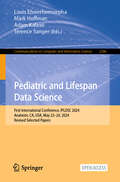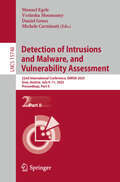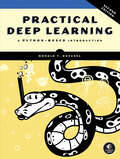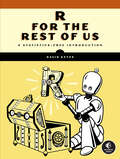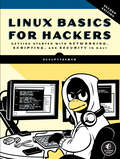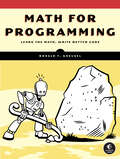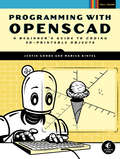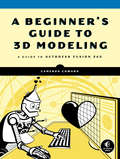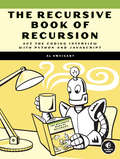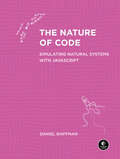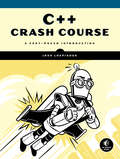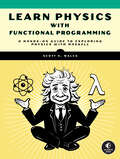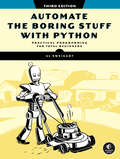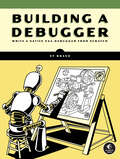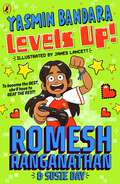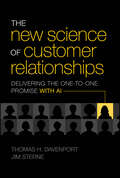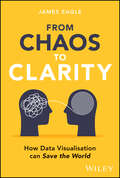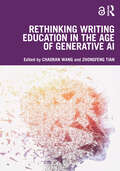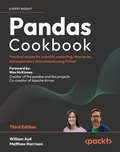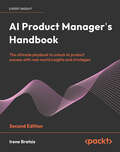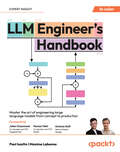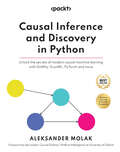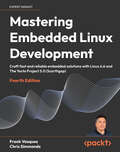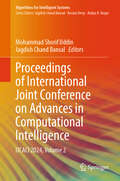- Table View
- List View
Pediatric and Lifespan Data Science: First International Conference, IPLDSC 2024, Anaheim, CA, USA, May 23–24, 2024, Revised Selected Papers (Communications in Computer and Information Science #2386)
by Mark Hoffman Louis Ehwerhemuepha Adam Kalawi Terence SangerThis open access book will address the unique requirements and technological tools for analysis of data across the lifespan, from childhood through advanced age. Topics such as sepsis, hospital-acquired infections, mental health, health equity, precision medicine, large language models and generative artificial intelligence, computer vision, ethical use of artificial intelligence, and large real-world electronic health record databases will be covered.
Detection of Intrusions and Malware, and Vulnerability Assessment: 22nd International Conference, DIMVA 2025, Graz, Austria, July 9–11, 2025, Proceedings, Part II (Lecture Notes in Computer Science #15748)
by Daniel Gruss Michele Carminati Manuel Egele Veelasha MoonsamyThe two-volume set LNCS 15747 and 15748 constitutes the refereed conference proceedings of the 12nd International Conference on Detection of Intrusions and Malware, and Vulnerability Assessment, DIMVA 2025, held in Graz, Austria, during July 9–11, 2025. The 25 revised full papers and 11 posters are presented in these proceedings were carefully reviewed and selected from 103 submissions. The papers are organized in the following topical sections: Part I: Web Security; Vulnerability Detection; Side channels; and Obfuscation. Part II: AI/ML & Security; Android & Patches; OS & Network; and Resilient Systems.
Practical Deep Learning, 2nd Edition: A Python-Based Introduction
by Ronald T. KneuselDeep learning made simple.Dip into deep learning without drowning in theory with this fully updated edition of Practical Deep Learning from experienced author and AI expert Ronald T. Kneusel.After a brief review of basic math and coding principles, you&’ll dive into hands-on experiments and learn to build working models for everything from image analysis to creative writing, and gain a thorough understanding of how each technique works under the hood. Whether you&’re a developer looking to add AI to your toolkit or a student seeking practical machine learning skills, this book will teach you:How neural networks work and how they&’re trainedHow to use classical machine learning modelsHow to develop a deep learning model from scratchHow to evaluate models with industry-standard metricsHow to create your own generative AI modelsEach chapter emphasizes practical skill development and experimentation, building to a case study that incorporates everything you&’ve learned to classify audio recordings. Examples of working code you can easily run and modify are provided, and all code is freely available on GitHub. With Practical Deep Learning, second edition, you&’ll gain the skills and confidence you need to build real AI systems that solve real problems.New to this edition: Material on computer vision, fine-tuning and transfer learning, localization, self-supervised learning, generative AI for novel image creation, and large language models for in-context learning, semantic search, and retrieval-augmented generation (RAG).
R for the Rest of Us: A Statistics-Free Introduction
by David KeyesLearn how to use R for everything from workload automation and creating online reports, to interpreting data, map making, and more.Written by the founder of a very popular online training platform for the R programming language!The R programming language is a remarkably powerful tool for data analysis and visualization, but its steep learning curve can be intimidating for some. If you just want to automate repetitive tasks or visualize your data, without the need for complex math, R for the Rest of Us is for you.Inside you&’ll find a crash course in R, a quick tour of the RStudio programming environment, and a collection of real-world applications that you can put to use right away. You&’ll learn how to create informative visualizations, streamline report generation, and develop interactive websites—whether you&’re a seasoned R user or have never written a line of R code.You&’ll also learn how to:• Manipulate, clean, and parse your data with tidyverse packages like dplyr and tidyr to make data science operations more user-friendly• Create stunning and customized plots, graphs, and charts with ggplot2 to effectively communicate your data insights• Import geospatial data and write code to produce visually appealing maps automatically• Generate dynamic reports, presentations, and interactive websites with R Markdown and Quarto that seamlessly integrate code, text, and graphics• Develop custom functions and packages tailored to your specific needs, allowing you to extend R&’s functionality and automate complex tasksUnlock a treasure trove of techniques to transform the way you work. With R for the Rest of Us, you&’ll discover the power of R to get stuff done. No advanced statistics degree required.
Linux Basics for Hackers, 2nd Edition: Getting Started with Networking, Scripting, and Security in Kali
by OccupyTheWebA revised introduction to the Linux operating system for beginning hackers and penetration testers.If you&’re just getting started along the exciting path of hacking, cybersecurity, and pentesting, Linux Basics for Hackers is an excellent introduction. With Kali Linux, an operating system designed for digital forensics and penetration testing, you&’ll learn the basics of using Linux and acquire the tools and techniques you&’ll need to take control of a Linux environment.First, you&’ll learn how to install Kali on a virtual machine and get an introduction to basic Linux concepts. Next, you&’ll tackle broader Linux topics like manipulating text, controlling file and directory permissions, and managing user environment variables. You&’ll then focus on foundational hacking concepts like security and anonymity and learn scripting skills with bash and Python. Practical tutorials and exercises throughout will reinforce and test your skills as you learn how to:Cover your tracks by changing your network information and manipulating the journalctl logging utilityWrite a tool to scan for network connections, and connect and listen to wireless networksKeep your internet activity stealthy using Tor, proxy servers, VPNs, and encrypted emailWrite a bash script to find potential attack targets over a range of IP addressesUse and abuse services like MySQL, the Apache web server, and OpenSSHBuild your own hacking tools, such as remote spy cameras and password crackersNew to this edition: This second edition has been updated to address recent changes to Kali and Linux, including a more secure approach to root privileges, updates to Bluetooth and Linux logging functions, and a new chapter with advice on AI in cybersecurity.Hacking is complex, and there is no single way in. Why not start at the beginning with Linux Basics for Hackers?
Math for Programming
by Ronald T. KneuselA one-stop-shop for all the math you should have learned for your programming career.Every great programming challenge has mathematical principles at its heart. Whether you&’re optimizing search algorithms, building physics engines for games, or training neural networks, success depends on your grasp of core mathematical concepts. In Math for Programming, you&’ll master the essential mathematics that will take you from basic coding to serious software development. You&’ll discover how vectors and matrices give you the power to handle complex data, how calculus drives optimization and machine learning, and how graph theory leads to advanced search algorithms.Through clear explanations and practical examples, you&’ll learn to:Harness linear algebra to manipulate data with unprecedented efficiencyApply calculus concepts to optimize algorithms and drive simulationsUse probability and statistics to model uncertainty and analyze dataMaster the discrete mathematics that powers modern data structuresSolve dynamic problems through differential equationsWhether you&’re seeking to fill gaps in your mathematical foundation or looking to refresh your understanding of core concepts, Math for Programming will turn complex math into a practical tool you&’ll use every day.
Programming with OpenSCAD: A Beginner's Guide to Coding 3D-Printable Objects
by Justin Gohde Marius KintelProgramming with OpenSCAD is a STEM-focused, learn-to-code book for beginners that introduces core computational thinking concepts through the design of 3D-printable objects. Develop coding skills as you build increasingly complex 3D models and print them into fun games, puzzles, and more.OpenSCAD is freely available open source software that enables nondesigners to easily create 3D designs using a text-based programming language. It&’s a great language for beginners because the instant 3D visualization gives you immediate feedback on the results of your code. This book channels OpenSCAD&’s visual benefits and user-friendliness into a STEAM-focused, project-based tutorial that teaches the basics of coding, 3D printing, and computational thinking while you develop your spatial reasoning by creating 3D designs with OpenSCAD. Presuming no prior experience with either programming or 3D design, each chapter builds a scaffolded understanding of core concepts. You&’ll start by defining, drawing and displaying geometric primitives with text-based code, then expand your creative toolbox with transformation operations – like rotating, reflecting, scaling, and combining shapes. As the projects become more sophisticated, so will your programming skills; you&’ll use loops for replicating objects, if statements for differentiating your designs, and parameterized, self-contained modules to divide longer scripts into separate files. Along the way, you'll learn 3D printing tips so that you can produce physical mementos of your progress and get physical feedback that lets you correct mistakes in real time. In addition, the book provides hands-on and accessible design exercises at the end of each chapter so that you can practice applying new concepts immediately after they are introduced. You&’ll learn:Programming basics like working with variables, loops, conditional statements, and parameterized modulesTransformation operations, such as rotate, reflect, and scale, to create complex shapesExtrusion techniques for turning 2D shapes into elaborate 3D designsComputational-thinking concepts, including decomposition, abstraction, and pattern recognition OpenSCAD&’s Boolean, Minkowski and hull operations for combining multiple 3D shapes into one3D design fundamentals, like navigating the xyz-axis, orthogonal vs. perspective views, and constructive solid geometryOrganizing bigger designs into separate files to make code more readable and collaborative Accessibly written for a wide audience (advanced middle schoolers, high school students, college students, artists, makers and lifelong-learners alike), this is the perfect guide to becoming proficient at programming in general and 3D modeling in particular.
A Beginner's Guide to 3D Modeling: A Guide to Autodesk Fusion 360
by Cameron CowardA Beginner&’s Guide to 3D Modeling is a project-based, straightforward introduction to computer-aided design (CAD). You&’ll learn how to use Autodesk Fusion 360, the world&’s most powerful free CAD software, to model gadgets, 3D print your designs, and create realistic images just like an engineering professional—with no experience required! Hands-on modeling projects and step-by-step instructions throughout the book introduce fundamental 3D modeling concepts. As you work through the projects, you&’ll master the basics of parametric modeling and learn how to create your own models, from simple shapes to multipart assemblies. Once you&’ve mastered the basics, you&’ll learn more advanced modeling concepts like sweeps, lofts, surfaces, and rendering, before pulling it all together to create a robotic arm. You&’ll learn how to:• Design a moving robotic arm, a door hinge, a teapot, and a 20-sided die• Create professional technical drawings for manufacturing and patent applications • Model springs and other complex curves to create realistic designs • Use basic Fusion 360 tools like Extrude, Revolve, and Hole• Master advanced tools like Coil and ThreadWhether you&’re a maker, hobbyist, or artist, A Beginner&’s Guide to 3D Modeling is certain to show you how to turn your ideas into professional models. Go ahead—dust off that 3D printer and feed it your amazing designs.
The Recursive Book of Recursion: Ace the Coding Interview with Python and JavaScript
by Al SweigartAn accessible yet rigorous crash course on recursive programming using Python and JavaScript examples.Recursion has an intimidating reputation: it&’s considered to be an advanced computer science topic frequently brought up in coding interviews. But there&’s nothing magical about recursion. The Recursive Book of Recursion uses Python and JavaScript examples to teach the basics of recursion, exposing the ways that it&’s often poorly taught and clarifying the fundamental principles of all recursive algorithms. You&’ll learn when to use recursive functions (and, most importantly, when not to use them), how to implement the classic recursive algorithms often brought up in job interviews, and how recursive techniques can help solve countless problems involving tree traversal, combinatorics, and other tricky topics. This project-based guide contains complete, runnable programs to help you learn: How recursive functions make use of the call stack, a critical data structure almost never discussed in lessons on recursionHow the head-tail and &“leap of faith&” techniques can simplify writing recursive functionsHow to use recursion to write custom search scripts for your filesystem, draw fractal art, create mazes, and moreHow optimization and memoization make recursive algorithms more efficient Al Sweigart has built a career explaining programming concepts in a fun, approachable manner. If you&’ve shied away from learning recursion but want to add this technique to your programming toolkit, or if you&’re racing to prepare for your next job interview, this book is for you.
The Nature of Code: Simulating Natural Systems with JavaScript
by Daniel ShiffmanAll aboard The Coding Train! This beginner-friendly creative coding tutorial is designed to grow your skills in a fun, hands-on way as you build simulations of real-world phenomena with &“The Coding Train&” YouTube star Daniel Shiffman.What if you could re-create the awe-inspiring flocking patterns of birds or the hypnotic dance of fireflies—with code? For over a decade, The Nature of Code has empowered countless readers to do just that, bridging the gap between creative expression and programming. This innovative guide by Daniel Shiffman, creator of the beloved Coding Train, welcomes budding and seasoned programmers alike into a world where code meets playful creativity.This JavaScript-based edition of Shiffman&’s groundbreaking work gently unfolds the mysteries of the natural world, turning complex topics like genetic algorithms, physics-based simulations, and neural networks into accessible and visually stunning creations.Embark on this extraordinary adventure with projects involving:A physics engine: Simulate the push and pull of gravitational attraction.Flocking birds: Choreograph the mesmerizing dance of a flock.Branching trees: Grow lifelike and organic tree structures.Neural networks: Craft intelligent systems that learn and adapt.Cellular automata: Uncover the magic of self-organizing patterns.Evolutionary algorithms: Play witness to natural selection in your code.Shiffman&’s work has transformed thousands of curious minds into creators, breaking down barriers between science, art, and technology, and inviting readers to see code not just as a tool for tasks but as a canvas for boundless creativity.Whether you&’re deciphering the elegant patterns of natural phenomena or crafting your own digital ecosystems, Shiffman&’s guidance is sure to inform and inspire. The Nature of Code is not just about coding; it&’s about looking at the natural world in a new way and letting its wonders inspire your next creation. Dive in and discover the joy of turning code into art—all while mastering coding fundamentals along the way.NOTE: All examples are written with p5.js, a JavaScript library for creative coding, and are available on the book's website.
C++ Crash Course: A Fast-Paced Introduction
by Josh LospinosoA fast-paced, thorough introduction to modern C++ written for experienced programmers. After reading C++ Crash Course, you'll be proficient in the core language concepts, the C++ Standard Library, and the Boost Libraries.C++ is one of the most widely used languages for real-world software. In the hands of a knowledgeable programmer, C++ can produce small, efficient, and readable code that any programmer would be proud of.Designed for intermediate to advanced programmers, C++ Crash Course cuts through the weeds to get you straight to the core of C++17, the most modern revision of the ISO standard. Part 1 covers the core of the C++ language, where you'll learn about everything from types and functions, to the object life cycle and expressions. Part 2 introduces you to the C++ Standard Library and Boost Libraries, where you'll learn about all of the high-quality, fully-featured facilities available to you. You'll cover special utility classes, data structures, and algorithms, and learn how to manipulate file systems and build high-performance programs that communicate over networks. You'll learn all the major features of modern C++, including:Fundamental types, reference types, and user-defined typesThe object lifecycle including storage duration, memory management, exceptions, call stacks, and the RAII paradigm Compile-time polymorphism with templates and run-time polymorphism with virtual classesAdvanced expressions, statements, and functionsSmart pointers, data structures, dates and times, numerics, and probability/statistics facilitiesContainers, iterators, strings, and algorithmsStreams and files, concurrency, networking, and application developmentWith well over 500 code samples and nearly 100 exercises, C++ Crash Course is sure to help you build a strong C++ foundation.
Learn Physics with Functional Programming: A Hands-on Guide to Exploring Physics with Haskell
by Scott N. WalckDeepen your understanding of physics by learning to use the Haskell functional programming language.Learn Physics with Functional Programming is your key to unlocking the mysteries of theoretical physics by coding the underlying math in Haskell.You&’ll use Haskell&’s type system to check that your code makes sense as you deepen your understanding of Newtonian mechanics and electromagnetic theory, including how to describe and calculate electric and magnetic fields.As you work your way through the book&’s numerous examples and exercises, you&’ll learn how to:Encode vectors, derivatives, integrals, scalar fields, vector fields, and differential equationsExpress fundamental physical principles using the logic of Haskell&’s type system to clarify Newton&’s second law, Coulomb&’s law, the Biot-Savart law, and the Maxwell equationsUse higher-order functions to express numerical integration and approximation methods, such as the Euler method and the finite-difference time-domain (FDTD) methodCreate graphs, models, and animations of physical scenarios like colliding billiard balls, waves in a guitar string, and a proton in a magnetic fieldWhether you&’re using this book as a core textbook for a computational physics course or for self-study, Learn Physics with Functional Programming will teach you how to use the power of functional programming to explore the beautiful ideas of theoretical physics.
Automate the Boring Stuff with Python, 3rd Edition
by Al SweigartThe bestselling introduction to Python programming, revised to include the latest Python features, improved explanations, and new chapters about databases and sound files.If you&’ve ever spent hours renaming files or updating hundreds of spreadsheet cells, you know how tedious tasks like these can be. But what if you could have your computer do this work for you?In this fully revised third edition of Automate the Boring Stuff with Python, you&’ll learn how to use Python to write programs that do in minutes what would take you hours to do by hand—no prior programming experience required. Early chapters will teach you the fundamentals of Python through clear explanations and engaging examples. You&’ll write your first Python program; work with strings, lists, dictionaries, and other data structures; then use regular expressions to find and manipulate text patterns. Once you&’ve mastered the basics, you&’ll tackle projects that teach you to use Python to automate tasks like: Searching the web, downloading content, and filling out formsFinding, extracting, and manipulating text and data in files and spreadsheetsCopying, moving, renaming, or compressing saved files on your computerSplitting, merging, and extracting text from PDFs and Word documentsInteracting with applications through custom mouse and keyboard macrosManaging your inbox, unsubscribing from lists, and sending email or text notificationsNew to this edition: All code and examples have been thoroughly updated. You&’ll also find four new chapters on database integration, speech recognition, and audio and video editing, as well as 16 new programming projects and expanded coverage of developer techniques like creating command line programs.Don&’t spend your time on work a well-trained monkey could do. Even if you&’ve never written a line of code, you can pass off that grunt work to your computer. Learn how in Automate the Boring Stuff with Python.
Building a Debugger: Write a Native x64 Debugger From Scratch
by Sy BrandMaster the inner workings of your x64 Linux system and expand your OS expertise by writing your very own debugger using C++.If debuggers seem like magic to you, there is no better way to demystify them than to write your own. This book will show you exactly how to do it, walking you through the entire process of building a debugger for x64 Linux systems using C++. As go from an empty filesystem folder to a fully fledged debugger capable of setting breakpoints, stepping through code, manipulating variables, and more, you&’ll learn how to:Attach to a processRead and write to registersSet hardware and software breakpointsOutput disassemblySupport multithreading and other tasksAs you add features to your debugger, you&’ll also pick up a wealth of knowledge about operating systems, compilers, software testing, and low-level programming that you can use in your day-to-day development.
Yasmin Bandara Levels Up!: The brand-new children’s book from comedian Romesh Ranganathan!
by Romesh RanganathanFrom comedy superstar Romesh Ranganathan comes a second unique and hilarious middle-grade story, perfect for readers of David Baddiel, Little Badman and Adam B's Adam Wins the Internet!Yasmin Bandara has NO IDEA what she wants to be when she grows up.Her parents want her to become a doctor and focus on school, they won’t even let her play computer games unless it’s an educational one called Monkey House. Yasmin’s amazing at it, but yawn!So when her best friend Zane introduces her to an exciting football game called FifPro, Yasmin can’t get enough! She secretly plays whenever she can, hoping one day she’ll be as good as her favourite gamer, mysteriously known as ‘The Goat’.But balancing schoolwork with gaming is starting to make Yasmin’s head SPIN. And when she’s invited to play in tournaments for both games, she realises she’s got to make a choice.Can Yasmin make her parents proud AND beat The Goat, or will it be GAME OVER?
The New Science of Customer Relationships: Delivering the One-to-One Promise With AI
by Thomas H. Davenport Jim SterneA practical strategy guide for building profitable customer relationships using the latest AI science and tech The New Science of Customer Relationships: Delivering the One-to-One Promise with AI is a science-based and insightful new approach to integrating the latest generative AI technologies into your company's customer communications. Analytics and marketing experts Thomas Davenport and Jim Sterne walk you through the technology and tools you need to understand, the data you need to collect, the processes you need to implement, and the ethics you need to observe to build an industry-leading customer relationship framework. In the book, you'll learn to create systems that reliably generate smart, persuasive, and hyper-personalized interactions with your company's best customers. You'll also discover how to integrate these systems directly into your firm's existing operations so you can use the tools to realize tangible financial results. Inside the book: Tips for using generative AI to analyze customer responses and extract actionable insights about how they feel and what they think Specific tools and technologies you can use to collect customer data and conduct effective analytics to improve your products and services Discussions of ethical guidelines to guide your organization's data and customer communication practices Perfect for marketers, sales team leaders, technology professionals, and anyone else responsible for evolving their company's customer relationships, The New Science of Customer Relationships is a hands-on playbook that explains the science of the latest customer communication technologies and walks you through exactly how to implement them.
From Chaos to Clarity: How Data Visualization can Save the World
by James EagleA radical wake up call for world overloaded with data and how data visualisation could be the answer In From Chaos to Clarity: How Data Visualisation Can Save the World, celebrated data visualisation creator James Eagle reveals how our data-saturated age harbours hidden dangers that places humanity in peril. He looks at how masterful visual storytelling might be our salvation. Through vivid examples and profound insights, James Eagle exposes the data pollution clouding modern life, whilst demonstrating how thoughtful, human-centred data visuals can cut through the noise, sharpen our collective understanding and light the path toward a more discerning future. Inside the book: How to unlock the human side of data visualisation by using empathy and storytelling Understanding our brain's deep connection to pictures and stories, and why this matters in this digital age Ways data visualisation can restore our human understanding of this world and tackle misinformation This is a must-read urgent message on how data visualisation is needed to confront data overload and misuse. From Chaos to Clarity is perfect for professionals in finance, engineering, science, mathematics and health, as well as journalists, writers, data scientists, and anyone interested in visual storytelling, reclaiming truth and sharpening our collective thinking to tackling some of the biggest challenges we face in this world.
Rethinking Writing Education in the Age of Generative AI
by Zhongfeng Tian Chaoran WangBringing together leading scholars and practitioners, Rethinking Writing Education in the Age of Generative AI offers a timely exploration of pressing issues in writing pedagogies within an increasingly AI-mediated educational landscape.From conceptual and empirical work to theory-guided praxis, the book situates the challenges we face today within the historical evolution of writing education and our evolving relationship with AI technologies. Covering a range of contexts such as L2/multilingual writing, first-year writing, writing centers, and writing program administration and faculty development, the book examines various AI-informed writing pedagogies and practices. Drawing on interdisciplinary perspectives from writing studies, education, and applied linguistics, the book bridges theory and practice to address critical questions of innovation, ethics, and equity in AI-supported teaching.This book is essential for writing educators and researchers looking to leverage AIs to facilitate the teaching and learning of writing in critical and transformative ways.
Microsoft 365 and SharePoint Online Cookbook: A complete guide to Microsoft Office 365 apps including SharePoint, Power Platform, Copilot and more
by Scott Brewster Nate Chamberlain Gaurav Mahajan Sudeep GhatakUnlock over 100 recipes for mastering Microsoft 365. Boost productivity with Copilot, collaborate with SharePoint and Teams, automate tasks, create apps and reports using Power Automate (with RPA), Power Apps, Power BI, and more. Print or Kindle book purchase includes a free PDF eBook.Key FeaturesEnhance collaboration and productivity using SharePoint, Teams, OneDrive, Viva, Planner, and Microsoft FormsAutomate processes, build apps, bots, and dashboards with Power Automate (with RPA), Power Apps, Copilot Studio, and Power BIHarness Copilot, the new AI virtual assistant, for seamless support in your everyday tasksBook DescriptionMicrosoft 365 offers tools for content management, communication, process automation, and report creation. Microsoft 365 and SharePoint Online Cookbook maximizes workplace collaboration and productivity using SharePoint Online, Teams, OneDrive, Delve, M365 Search, Copilot, Power Platform, Viva, Planner, and Microsoft Forms. You will find thoroughly updated recipes for SharePoint Online, covering sites, lists, libraries, pages, web parts, and learn SharePoint Framework (SPFx) basics for building solutions. You will explore many Microsoft Teams recipes to prepare it to be your organization’s central collaboration hub. You will be able to unlock Power Platform potential with recipes for Power Apps to enable low-code/no-code app development and learn to automate tasks with Power Automate and Power Automate Desktop. The book teaches you data visualization with Power BI, and chatbot creation with Power Virtual Agents (Copilot Studio). Finally, you will also learn about the cutting-edge Copilot and Gen AI functionality in Microsoft 365 and Power Platform. By the end, you will be equipped with skills to effectively use Microsoft 365, SharePoint Online, and the Power Platform. Whether it's enhancing career prospects or improving business operations, this book is a perfect companion on your journey through the Microsoft Office 365 suite.What you will learnCollaborate effectively with SharePoint, Teams, OneDrive, Delve, Search, and VivaBoost creativity and productivity with Microsoft CopilotDevelop and deploy custom applications using Power AppsCreate custom bots using Power Virtual Agents (Copilot Studio)Integrate with other apps, automate workflows and repetitive processes with Power Automate/Desktop (RPA)Design reports and engaging dashboards with Power BIUtilize Planner, To Do, and gather feedback with polls and surveys in Microsoft FormsExperience seamless integration in the mobile platformWho this book is forThis cookbook caters to professionals stepping into the world of Microsoft 365 and SharePoint Online. It is tailored for a broad spectrum of skillsets including general business professionals, IT administrators, and enterprise architects who are newcomers to Microsoft 365, offering valuable insights for establishing a contemporary, digital workplace effectively.
Pandas Cookbook: Practical recipes for scientific computing, time series, and exploratory data analysis using Python
by Matthew Harrison William AydFrom fundamental techniques to advanced strategies for handling big data, visualization, and more, this book equips you with skills to excel in real-world data analysis projects. Bonus: Free PDF copy + join our Discord + code filesKey FeaturesThis book targets features in pandas 2.x and beyondPractical, easy to implement recipes for quick solutions to common problems in data using pandasMaster the fundamentals of pandas to quickly begin exploring any datasetBook DescriptionUnlock the full power of pandas 2.x with this hands-on cookbook, designed for Python developers, data analysts, and data scientists who need fast, efficient solutions for real-world data challenges. This book provides practical, ready-to-use recipes to streamline your workflow. With step-by-step guidance, you'll master data wrangling, visualization, performance optimization, and scalable data analysis using pandas’ most powerful features. From importing and merging large datasets to advanced time series analysis and SQL-like operations, this cookbook equips you with the tools to analyze, manipulate, and visualize data like a pro. Learn how to boost efficiency, optimize memory usage, and seamlessly integrate pandas with NumPy, PyArrow, and databases. This book will help you transform raw data into actionable insights with ease. What you will learnThe pandas type system and how to best navigate itImport/export DataFrames to/from common data formatsData exploration in pandas through dozens of practice problemsGrouping, aggregation, transformation, reshaping, and filtering dataMerge data from different sources through pandas SQL-like operationsLeverage the robust pandas time series functionality in advanced analysesScale pandas operations to get the most out of your systemThe large ecosystem that pandas can coordinate with and supplementWho this book is forThis book is for Python developers, data scientists, engineers, and analysts. pandas is the ideal tool for manipulating structured data with Python and this book provides ample instruction and examples. Not only does it cover the basics required to be proficient, but it goes into the details of idiomatic pandas
AI Product Manager's Handbook: The ultimate playbook to unlock AI product success with real-world insights and strategies
by Irene BratsisBlending strategic frameworks, real-world case studies, and cutting-edge AI insights, this guide equips product managers with the tools to navigate challenges, drive innovation, and build scalable, high-impact AI products.Key FeaturesGain insights into AI product discovery, market fit, and execution through structured frameworks.Learn to translate complex AI capabilities into real-world solutions that drive value.Understand ethical AI, bias mitigation, and compliance to build responsible AI products.Purchase of the print or Kindle book includes a free PDF eBook.Book DescriptionAI is rapidly transforming product management, presenting new challenges and business opportunities. As AI-driven solutions become more complex, product managers must bridge the gap between technological capabilities and business needs. This book provides a detailed roadmap for successfully building and maintaining AI-driven products, serving as an indispensable companion on your journey to becoming an effective AI product manager. In this second edition, you'll find fresh insights into generative AI, and responsible AI practices with the most relevant tools for building AI-powered products. Authored by a leading AI product expert with years of hands-on experience in developing and managing AI solutions, this guide translates complex AI concepts into actionable strategies. Whether you're an aspiring AI PM or an experienced professional, this book offers a structured approach to defining AI product vision, leveraging data effectively, and aligning AI with business objectives. With new case studies and refined frameworks, this edition provides deeper insights into ethical AI, cross-functional collaboration, and deployment challenges. By the end of this book, you’ll be equipped with the knowledge to drive AI product success with key techniques for identifying AI opportunities and managing risks in a rapidly evolving landscape.What you will learnPlan your AI PM roadmap and navigate your career with clarity and confidenceGain a foundational understanding of AI/ML capabilitiesAlign your product strategy, nurture your team, and navigate the ongoing challenges of cost, tech, compliance, and risk managementIdentify pitfalls and green flags for optimal commercializationSeparate hype from reality and identify quick wins for AI enablement and GenAIUnderstand how to develop and manage both native and evolving AI productsBenchmark product success from a holistic perspectiveWho this book is forThis book is tailored for aspiring and experienced product managers, AI strategists, and business leaders aiming to integrate AI into their products. A foundational understanding of AI is expected and reinforced throughout the book. It is particularly valuable for professionals looking to bridge AI and business strategy, optimize AI/ML applications, and drive data-informed decision-making. Engineers, designers, and executives seeking to align AI capabilities with user needs and market demands will also benefit from the insights and real-world case studies on building scalable AI products.
LLM Engineer's Handbook: Master the art of engineering large language models from concept to production
by Maxime Labonne Paul IusztinStep into the world of LLMs with this practical guide that takes you from the fundamentals to deploying advanced applications using LLMOps best practicesKey FeaturesBuild and refine LLMs step by step, covering data preparation, RAG, and fine-tuningLearn essential skills for deploying and monitoring LLMs, ensuring optimal performance in productionUtilize preference alignment, evaluation, and inference optimization to enhance performance and adaptability of your LLM applicationsBook DescriptionArtificial intelligence has undergone rapid advancements, and Large Language Models (LLMs) are at the forefront of this revolution. This LLM book offers insights into designing, training, and deploying LLMs in real-world scenarios by leveraging MLOps best practices. The guide walks you through building an LLM-powered twin that’s cost-effective, scalable, and modular. It moves beyond isolated Jupyter notebooks, focusing on how to build production-grade end-to-end LLM systems. Throughout this book, you will learn data engineering, supervised fine-tuning, and deployment. The hands-on approach to building the LLM Twin use case will help you implement MLOps components in your own projects. You will also explore cutting-edge advancements in the field, including inference optimization, preference alignment, and real-time data processing, making this a vital resource for those looking to apply LLMs in their projects. By the end of this book, you will be proficient in deploying LLMs that solve practical problems while maintaining low-latency and high-availability inference capabilities. Whether you are new to artificial intelligence or an experienced practitioner, this book delivers guidance and practical techniques that will deepen your understanding of LLMs and sharpen your ability to implement them effectively.What you will learnImplement robust data pipelines and manage LLM training cyclesCreate your own LLM and refine it with the help of hands-on examplesGet started with LLMOps by diving into core MLOps principles such as orchestrators and prompt monitoringPerform supervised fine-tuning and LLM evaluationDeploy end-to-end LLM solutions using AWS and other toolsDesign scalable and modularLLM systemsLearn about RAG applications by building a feature and inference pipelineWho this book is forThis book is for AI engineers, NLP professionals, and LLM engineers looking to deepen their understanding of LLMs. Basic knowledge of LLMs and the Gen AI landscape, Python and AWS is recommended. Whether you are new to AI or looking to enhance your skills, this book provides comprehensive guidance on implementing LLMs in real-world scenarios
Causal Inference and Discovery in Python: Unlock the secrets of modern causal machine learning with DoWhy, EconML, PyTorch and more
by Aleksander Molak Ajit JaokarDemystify causal inference and casual discovery by uncovering causal principles and merging them with powerful machine learning algorithms for observational and experimental dataPurchase of the print or Kindle book includes a free PDF eBookKey FeaturesExamine Pearlian causal concepts such as structural causal models, interventions, counterfactuals, and moreDiscover modern causal inference techniques for average and heterogenous treatment effect estimationExplore and leverage traditional and modern causal discovery methodsBook DescriptionCausal methods present unique challenges compared to traditional machine learning and statistics. Learning causality can be challenging, but it offers distinct advantages that elude a purely statistical mindset. Causal Inference and Discovery in Python helps you unlock the potential of causality.You'll start with basic motivations behind causal thinking and a comprehensive introduction to Pearlian causal concepts, such as structural causal models, interventions, counterfactuals, and more. Each concept is accompanied by a theoretical explanation and a set of practical exercises with Python code.Next, you'll dive into the world of causal effect estimation, consistently progressing towards modern machine learning methods. Step-by-step, you'll discover Python causal ecosystem and harness the power of cutting-edge algorithms. You'll further explore the mechanics of how “causes leave traces” and compare the main families of causal discovery algorithms.The final chapter gives you a broad outlook into the future of causal AI where we examine challenges and opportunities and provide you with a comprehensive list of resources to learn more.What you will learnMaster the fundamental concepts of causal inferenceDecipher the mysteries of structural causal modelsUnleash the power of the 4-step causal inference process in PythonExplore advanced uplift modeling techniquesUnlock the secrets of modern causal discovery using PythonUse causal inference for social impact and community benefitWho this book is forThis book is for machine learning engineers, data scientists, and machine learning researchers looking to extend their data science toolkit and explore causal machine learning. It will also help developers familiar with causality who have worked in another technology and want to switch to Python, and data scientists with a history of working with traditional causality who want to learn causal machine learning. It's also a must-read for tech-savvy entrepreneurs looking to build a competitive edge for their products and go beyond the limitations of traditional machine learning.
Mastering Embedded Linux Development: Craft fast and reliable embedded solutions with Linux 6.6 and The Yocto Project 5.0 (Scarthgap)
by Chris Simmonds Frank VasquezWritten by Frank Vasquez, an embedded Linux expert, this new edition enables you to harness the full potential of Linux to create versatile and robust embedded solutions All formats include a free PDF and an invitation to the Embedded System Professionals communityKey FeaturesLearn how to develop and configure reliable embedded Linux devicesDiscover the latest enhancements in Linux 6.6 and the Yocto Project 5.0, codename ScarthgapExplore different ways to debug and profile your code in both user space and the Linux kernelPurchase of the print or Kindle book includes a free PDF eBookBook DescriptionMastering Embedded Linux Development is designed to be both a learning resource and a reference for your embedded Linux projects. In this fourth edition, you'll learn the fundamental elements that underpin all embedded Linux projects: the toolchain, the bootloader, the kernel, and the root filesystem. First, you will download and install a pre-built toolchain. After that, you will cross-compile each of the remaining three elements from scratch and learn to automate the process using Buildroot and the Yocto Project. The book progresses with coverage of over-the-air software updates and rapid prototyping with add-on boards. Two new chapters tackle modern development practices, including Python packaging and deploying containerized applications. These are followed by a chapter on writing multithreaded code and another on techniques to manage memory efficiently. The final chapters demonstrate how to debug your code, whether it resides in user space or in the Linux kernel itself. In addition to GNU debugger (GDB), the book also covers the different tracers and profilers that are available for Linux so that you can quickly pinpoint any performance bottlenecks in your system. By the end of this book, you will be able to create efficient and secure embedded devices with Linux that will delight your users.What you will learnCross-compile embedded Linux images with Buildroot and YoctoEnable Wi-Fi and Bluetooth connectivity with a Yocto board support packageUpdate IoT devices securely in the field with Mender or balenaPrototype peripheral additions by connecting add-on boards, reading schematics, and coding test programsDeploy containerized software applications on edge devices with DockerDebug devices remotely using GDB and measure the performance of systems using tools like perf and plyWho this book is forIf you are a systems software engineer or system administrator who wants to learn how to apply Linux to embedded devices, then this book is for you. The book is also for embedded software engineers accustomed to programming low-power microcontrollers and will help them make the leap to a high-speed system-on-chips that can run Linux. Anyone who develops hardware for Linux will find something useful in this book. But before you get started, you will need a solid grasp of the POSIX standard, C programming, and shell scripting.
Proceedings of International Joint Conference on Advances in Computational Intelligence: IJCACI 2024, Volume 2 (Algorithms for Intelligent Systems)
by Jagdish Chand Bansal Mohammad Shorif UddinThis book gathers outstanding research papers presented at the 8th International Joint Conference on Advances in Computational Intelligence (IJCACI 2024), held in hybrid mode at South Asian University, New Delhi, India, during October 5–6, 2024. IJCACI 2024 is jointly organized by Jahangirnagar University (JU), Bangladesh, and South Asian University (SAU), India. The book presents the novel contributions in areas of computational intelligence, and it serves as a reference material for advance research. The topics covered are collective intelligence, soft computing, optimization, cloud computing, machine learning, intelligent software, robotics, data science, data security, big data analytics, and signal and natural language processing.
